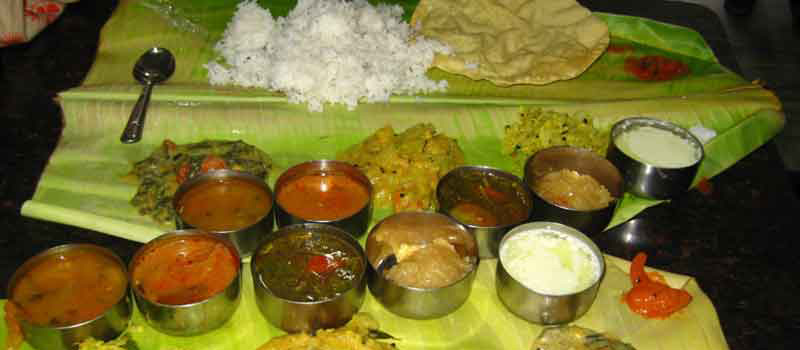Banana Leaves

Content Source : https://www.tamilnadutourism.com/traditions/banana-leaves.php
Traditional way of Eating:
Banana leaves play a vital role in Indian tradition. Whatever functions or gathering it may be, food is served in the wide banana leaves. Especially people of South India use Banana leaves in a higher ratio than the north. There are surplus benefits in eating on the banana leaf.

From time immemorial people of South, use banana leaf to serve and pack food. As plantain tree is grown largely at south, people find it very comfortable and beneficial to use banana leaves. Coming to the banana tree, it is the only tree in the world which is edible and useful from tip to root. Every part of the tree is used for one or the other purpose.
The leaves are used for serving food, flowers are edible and Tamilians make curry out it, fruits are very tasty, unripen fruits are also used for cooking, stem is a great remedy for kidney stones, the bark is used to tie flowers and make garlands, and the roots give birth to a sapling before they become fruitless.
This is the reason why every marriages in South India is adorned with a pair of plantain tree at the threshold of the function hall. Like this plantain tree everyone should lead their life usefully and be helpful to others till their last breath. Most of the houses in Tamilnadu and Kerala have banana trees in their backyard.
Benefits of eating on banana leaf:
The first and foremost reason why banana leaf is used for serving food is because of its wide size and the partition that runs at centre which gives enough space to place variety of foods in a single leaf without mixing with each other. As Indian lunches are diverse and have many courses, only banana leaf can accommodate all courses and it is water proof too, which is very helpful for eating liquid dishes like Sambar, Rasam, curd, and Payasam.
- Tender leaves are flexible and can be folded in any angle.
- These leaves are non-sticky and so it is used for lining steamer trays
- One of the major benefits of this leaf is that they are bio degradable and it won’t be a problem to discard them. Even burning these leaves is not harmful to the atmosphere.
- Tamilians consider it to be an act of respect to serve the guests in banana leaf.
- Eating hot food in this leaf is very healthy and hygienic. While the hot food is served on the leaf, rich nutrients from the leaf is emitted, which infuses with the food and eventually we intake it as we eat the food.
- These leaves are rich in polyphenols such as epigallocatechin gallate, or EGCG, which is found in green tea.
- Polyphenols are natural antioxidants found in many plant based foods. So eating on a plantain tree increases the EGCG level in our body and slows down the process of aging.
- Top of all, the aroma that arises from the leaf when the hot food is laid on it is incredible. Even the ones don’t feel hungry would, find their mouthwatering when the food is served on the plantain leaf.
- Even in USA a journal “American Journal of Clinical Nutrition,” is conducting an extensive research on how polyphenols affect human cells, the oxidative process and its impact on disease prevention.
Interesting Facts:
There are many rules and hidden meaning in placing the banana leaf. The proper position to lay the leaf is, the edge of the leaf should be to the left side of the consumer and the wide part should be to the right side (if it is a half leaf). In the case of full single leaf ( Thalai valai ilai), which is served to very important and respectable person in the family, the leaf should be laid in the way that the lines in the leaf goes from right to left.
There is a hidden meaning in way of folding the leaf after eating. If the consumer folds the leaf towards him, it means he is satisfied with the food and the respect he has received and he promises that he will attend more functions like this in future. But if he folds the other way (opposite to him) it denotes he is not satisfied with the hospitality he has received and he is not willing to come back again.
So mostly in happy functions like marriages, temple festivals, child naming ceremony and etc, people used to fold the leaves towards themselves, stating that they will come back to merry functions like this in future. In the case of death anniversary or other sorrowful gathering they will fold the leaves in the opposite way, denoting that they feel sad and don’t want to attend sad functions like this in future.
Comments
No feedback Available






Leave a Reply
No feedback Available